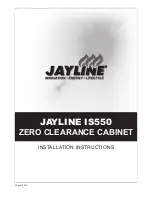
23340-2-1007
Page 50
Important
1. The following service procedures are provided as a general
guide.
2. Meter readings between gas control and ignition module must
be taken within the trial for ignition period. Once the igni-
tion module locks out, the system must be reset by setting the
thermostat down for at least one minute before continuing.
3. If any component does not function properly, make sure it is
correctly installed and wired before replacing it.
4. The ignition module cannot be repaired. If it malfunctions, it
must be replaced.
5. Only trained, experienced service technicians should service
intermittent pilot systems.
Perform the
CHECKOUT
steps on page 48 as the first step in
troubleshooting. Then check
TROUBLESHOOTING GUIDE
to pinpoint the cause of the problem. If troubleshooting indicates
an ignition problem, see
Ignition System Checks
below to isolate
and correct the problem.
Following troubleshooting, perform the
CHECKOUT
procedure
(page 48) again to be sure system is operating normally.
Ignition System Checks
Step 1: Check ignition cable.
Make sure:
A. Ignition cable does not touch any metal surfaces.
B. Ignition cable is no more than 36 inches long.
C. Connections to the ignition module and to the igniter-sensor
are clean and tight.
D. Ignition cable provides good electrical continuity.
Step 2: Check ignition system grounding.
Nuisance shutdowns are often caused by a poor or erratic
ground.
A. A common ground, usually supplied by the pilot burner bracket,
is required for the module and the pilot burner/igniter sen-
sor.
• Check for good metal-to-metal contact between the pilot
burner bracket and the main burner.
• Check the ground lead from GND (BURNER) terminal on
the module to the pilot burner. Make sure connections are
clean and tight. If the wire is damaged or deteriorated, replace
it with No. 14-18 gauge, moisture-resistant, thermoplastic
insulated wire with 105 C (221 F) minimum rating.
• If flame rod or bracket are bent out of position, restore to
correct position.
• Replace pilot burner/igniter sensor if insulator is
cracked.
Step 3: Check spark ignition circuit.
You will need a short jumper
wire made from ignition cable or other heavily insulated
wire.
A. Close the manual gas valve.
B. Disconnect the ignition cable at the SPARK terminal on the
module.
WARNING
When performing the following steps, do not touch stripped
end of jumper or SPARK terminal. The ignition circuit
generates 13,000 volts at 25 pf load and electrical shock
can result.
C. Energize the module and immediately touch one end of the
jumper firmly to the GND terminal on the module. Move the
free end of the jumper slowly toward the SPARK terminal
until a spark is established.
D. Pull the jumper slowly away from the terminal and note the
length of the gap when sparking stops. Check table below.
ARC LENGTH
ACTION
No arc or arc less than 1/8
inch.
Arc 1/8 inch or longer.
Check external fuse, if
provided.
Verify power at module input
terminal.
Replace module if fuse and
power okay.
Voltage output is okay.
Step 4: Check pilot flame current.
A. Turn off furnace at thermostat.
B. Disconnect main valve wire from the TH or MV terminal on
the gas control.
C. Disconnect ground wire from GND (BURNER) terminal at
module.
D. Connect a meter (dc microamp scale) in series with the ground
lead.
• Disconnect ground lead from GND terminal on ignition
module.
• Connect the black (negative) meter lead to the ignition
module GND (BURNER) terminal.
• Connect the red (positive) meter lead to the free end of the
ground lead.
E. Set thermostat to call for heat. The spark will light the pilot but
the main burner will not light because the main valve actuator
is disconnected.
F. Read the meter. The flame sensor current must be steady and
at least 1.0 uA.
G. If the reading is less than the minimum or unsteady,
• Make sure pilot flame envelopes 3/8 to 1/2 inch of the flame
rod.
• If necessary, adjust pilot flame by turning the pilot adjustment
screw on the gas control clockwise to decrease or counter-
clockwise to increase pilot flame. Following adjustment,
always replace pilot adjustment cover screw and tighten
firmly to assure proper gas control operation.
• Check for cracked ceramic insulator, which can cause short
to ground, and replace igniter-sensor if necessary.
• Make sure electrical connections are clean and tight. Replace
damaged wire with moisture-resistant No. 18 wire rated for
continuous duty up to 105 C (221 F).
H. Remove meter and reconnect all wires. Return system to
normal operation before leaving job.
INTERMITTENT PILOT TROUBLESHOOTING (continued)
















































